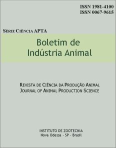Study of intake and apparent digestibility with sheeps of the pangola hay and pangola hay with 33% and 67%of the Indigofera hirsuta hay
Abstract
This trial was conducted at the Estação Experimental Central of the Instituto de Zootecnia, in Nova Odessa, State of São Paulo, Brazil, lo evaluate the nutritive value through intake and apparent digestibility of pangola hay and pangola hay with 33% or 67% of Indigofera hirsuta hay on a dry matter basis. Fifteen male castrated sheps with an average weight of 29.68 ± 2.09 kg were utilized on a total facces collection trial. The sheeps were vermifugated in the begnning of the trial. The digestibility coefficients were in general lower for the treatments with the Indigofera hay, and presented also a lower intake and nutritive value. the mean daily dry matter intake was 68.88 g/kg LW0 for the pangola hay, 51.55 g/kg LW0 for lhe pangola with 33% Indigofera and 49.0 g/kg LW0,75 for the pangola with 67% Indigofera. the TDN and nutritive value were, in the same order, 62.28%, 52.83%, 51.99%, and 42.87%, 27.17%, 25.69%. Although the lndigofera hay decreased the nutritive value; the digestible protein of the 67% treatment was higher than in the others.Downloads
Downloads
Published
Issue
Section
License
Os autores não serão remunerados pela publicação de trabalhos, pois devem abrir mão de seus direitos autorais em favor deste periódico. Por outro lado, os autores ficam autorizados a publicar seus artigos, simultaneamente, em repositórios da instituição de sua origem, desde que citada a fonte da publicação original seja Boletim de Indústria Animal. A revista se reserva o direito de efetuar, nos originais, alterações de ordem normativa, ortográfica e gramatical, com vistas a manter o padrão culto da língua e a credibilidade do veículo. Respeitará, no entanto, o estilo de escrever dos autores. Alterações, correções ou sugestões de ordem conceitual serão encaminhadas aos autores, quando necessário. Nesses casos, os artigos, depois de adequados, deverão ser submetidos a nova apreciação. As opiniões emitidas pelos autores dos artigos são de sua exclusiva responsabilidade. Todo o conteúdo deste periódico, exceto onde está identificado, está licenciado sob a Licença Creative Commons Attribution (CC-BY-NC). A condição BY implica que os licenciados podem copiar, distribuir, exibir e executar a obra e fazer trabalhos derivados com base em que só se dão o autor ou licenciante os créditos na forma especificada por estes. A cláusula NC significa que os licenciados podem copiar, distribuir, exibir e executar a obra e fazer trabalhos derivados com base apenas para fins não comerciais.













